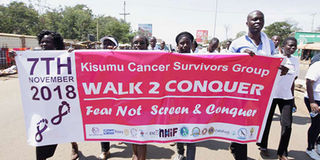With vaccine proven to be safe, time to eradicate cervical cancer

Kisumu residents create cancer awareness on November 7, 2018. PHOTO | FILE | NATION MEDIA GROUP
What you need to know:
- As the second most common cancer among women after breast cancer, 13.45 million women and girls from age 15 are at risk of cervical cancer.
- Cervical cancer is a sexually acquired infection with certain types of the Human Papillomavirus and most persons are infected shortly after the onset of sexual activity.
The number of cancer cases in Kenya continues to rise, especially among youth.
As the second most common cancer among women after breast cancer, 13.45 million women and girls from age 15 are at risk of cervical cancer.
An estimated 5,250 women are diagnosed with the disease annually and 3,286 die from it.
Cervical cancer is a sexually acquired infection with certain types of the Human Papillomavirus (HPV) and most persons are infected shortly after the onset of sexual activity.
There are more than 100 of types of HPV, which can also cause genital warts and anal and penile cancers.
VACCINES
In June 2006, Merck & Company produced the first HPV vaccine, Gardasil, for use in women aged nine to 26.
Last October, its use expanded to include women and men aged 27-45. Another vaccine, Cervarix (GlaxoSmithKline), is also available.
The World Health Organisation (WHO) says that by mid-2016, some 65 countries had introduced HPV vaccines.
Kenya is set to rollout the free HPV vaccine this year following a successful pilot programme among 20,000 schoolgirls in Kitui County, though it has been available in some private facilities since its approval in 2006.
Tanzania has an early age (nine-to-14 years) HPV vaccination programme.
SIDE EFFECTS
Despite the progress in preventing cervical cancer, there is opposition to the vaccine with reports of serious side effects causing public distrust and lowering vaccination rates. We need to get the facts right.
Adverse drug reactions are classified as minor, moderate, severe or lethal, depending on the severity.
Merck & Company reports the most common adverse reactions to Gardasil as pain, swelling and stinging at the injection site, headache, fever, nausea, diarrhoea, abdominal pain and dizziness.
GSK says Cervarix may cause headache, fatigue, gastrointestinal disturbances and muscle pain. All these are considered minor; for vaccines, they are not uncommon.
In the past decade, there have been reports of HPV vaccines causing chronic pain syndrome, seizures, disturbance of consciousness, paralysis, dizziness, asthma and memory impairment, among others.
There are also extreme claims that the HPV vaccine causes infertility and sudden death.
These symptoms can be classified as severe and can have a negative impact on everyday life of the recipients.
SAFETY
WHO’s Global Advisory Committee on Vaccine Safety (GACVS) investigated safety concerns raised about the HPV vaccines.
GACVS is an independent body composed of clinicians and expert scientists, who provide advice on safety of vaccines of global importance.
GACVS has not found any safety issue that would alter its recommendations for the use of the vaccines.
Additionally, the Centers for Disease Control and Prevention (CDC) found the vaccine safe with no difference in adverse effects between vaccinated and unvaccinated girls.
European Medicines Agency (EMA), the European drug regulator, did not find any link between the severe adverse effects and the HPV vaccines.
Recent studies suggest that the serious adverse reactions reported may be related to autoimmunity.
PREVENTION
This is misdirected immune response, where the immune system attacks the body’s own tissues and organs and can cause a broad range of illnesses.
It is normally triggered only in persons of certain particular genetic make-up, who are few.
It is of paramount importance to note that vaccination alone is not adequate in cervical cancer prevention.
The vaccine is not a cure to HPV infection. Cervical cancer prevention requires a comprehensive approach — including community education, social mobilisation, vaccination, screening and treatment.
Vaccination offers primary prevention to girls who are not yet sexually active.
Education on the importance of safe sexual practices such as delayed start of sexual activity and use of condoms is another preventive intervention.
Additionally, avoiding tobacco use and undergoing male circumcision are considered preventive.
Cervical cancer is treatable (through surgery, radiation and drug therapy) if detected at early stages. Diagnosis is done through a Pap smear test.
Dr Makanga, a neuropharmacologist, teaches pharmacy at Kenyatta University. [email protected]




